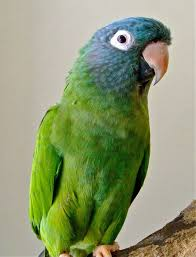Blue-Crowned Conure

Description
The blue-crowned parakeet is a medium-sized bird measuring approximately 37 cm (14.5 in) in length and weighing between 140 and 190 g (4.9 and 6.7 oz).
Blue-crowns are born with red coloring around the head, but blue-crowns are predominantly green, with dull blue coloring on the forehead, crown, cheeks, and ears in the nominate, but less blue in other subspecies. It has a ring of white featherless skin around each eye, though this is bright orange-yellow in wild T. acuticaudata neumanni. The breast feathers may also be tinged with blue, though they are more commonly green to yellow-green. Closed wing coloring matches that of the body while extended wings show blue-brown, becoming chestnut on the outer flight feathers. The tail feathers are green on top, maroon to red-brown on the underside, iridescing to bright orange and scarlet under full-spectrum light. Legs are pink-brown with grey-brown claws. The upper mandible is horn-colored, tapering to a needle-sharp, grey-black tip. In the southern and western nominate and subspecies neumanni, the lower mandible is horn-colored in juveniles, fading to grey-black by the bird's second year. The remaining eastern, central and northern subspecies retain the horn-colored lower mandible throughout adulthood.
Scientific Name
Aratinga Acuticaudata
Country Of Origin
South America
Size
Medium, 15 inches
Life Expectancy
up to 30 years
Noise Level
Moderate
Talk / Trick Ability
Moderate
Characteristics
One of the most popular conures, the blue-crowned conure enjoys chatting with its human companions and possess a intelligent, gentle and affectionate nature. Once overlooked because of what was considered as drab colors in the species, the blue-crowned conure gained popularity after the movie Paulie featured a blue crown. Owners who favor this pet bird like the colorful personality they demonstrate.
Behavior / Health Concerns
Blue-crowned Conures need interesting entertainment and interaction. Feather picking and susceptibility to psittacine diseases are the usual health concerns with this pet bird. A diet that consists of a combination of both pellets and sprouted seeds as well as fresh fruits, vegetables, nuts, cooked brown rice, beans or pasta. Provide your conure with plastic, wood, puzzle, musical, rope, leather and other varieties of toys.
Expert Advice
“Wonderful clowns, intelligent, rowdy, loud.”
Liz Wilson, CVT, CBPC